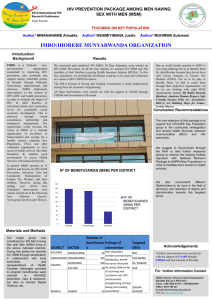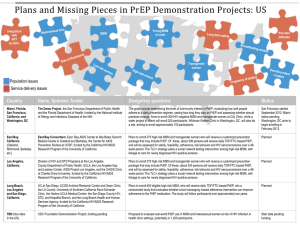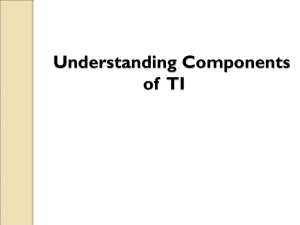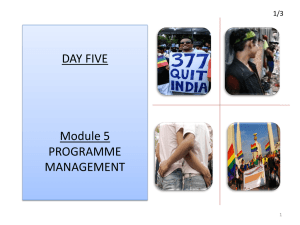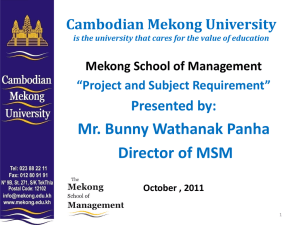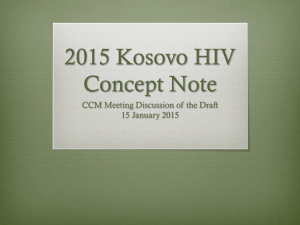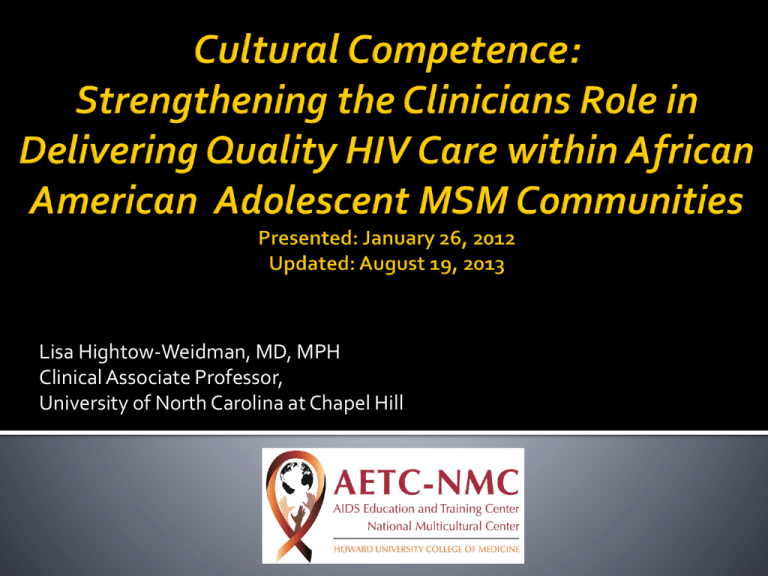
Lisa Hightow-Weidman, MD, MPH
Clinical Associate Professor,
University of North Carolina at Chapel Hill
Understand the impact of the HIV epidemic among
young black men who have sex with men (MSM)
Describe factors associated with disproportionate
infection rates
Provide an example of a successful HIV prevention
intervention with Black MSM
Identify important priorities for maintaining the
health and wellness of young Black MSM
MSM embodies a wide range of men with varying
social identities related to their sexual and or
relationship practices with other men.
The term “Black” is used to be inclusive of peoples
of African descent, including those who may be
from Africa, the Caribbean, as well as men born in
the U.S.
Youth/Young encompasses adolescents and young
adults ages 13-24 years.
Comparable or lower self-reported risks of UAI
Compared with other MSM, Black MSM have the
same number or smaller number of male sex
partners
Most studies show no racial differences in
prevalence of engaging in commercial sex work.
Millett , AJPH 2006; Harawa, JAIDS, 2004; Bingham, AIDS Ed Prev, 2003;
Stokes, J Sex Res, 1996; Bartholow, JAIDS, 2005, Newman, AJPH, 2004
Cross-sectional study of 1154 Black MSM and 1091
Latino MSM
Circumcision prevalence was higher among black MSM than
among Latino MSM (74% vs. 33%; P , 0.0001).
Circumcised MSM in both racial/ethnic groups were more likely than
uncircumcised MSM to be born in the US or to have a US born parent.
Circumcision status was not
associated with prevalent HIV infection among Latino or Black MSM.
was not associated with a reduced likelihood of HIV infection among
men who had only engaged in unprotected insertive anal sex.
Millett, JAIDS, 2007
Factors can influence risk
Sociocultural factors (racial discrimination,
homophobia and stigmatization)
Sexual network issues
High rates of STIs
Low testing rates
▪ Lack of awareness of ones own HIV status and leading to
continued risk behavior
Socioeconomic issues
▪ Poverty, incarceration, drug use, lack of access to care
BMSM are more likely than MSM of other races to identify as bisexual
and be bisexually active
Heterosexual identity and corresponding sexual behavior among black
men are sometimes incongruent, but this discordance is not exclusive
nor greatest among black men
BMSM are less likely than other MSM to disclose their homosexual
behavior or identity but non disclosing BMSM may engage in few
sexual risks with male partners than disclosing BMSM
Bisexual Activity among HIV-positive Men of Various Sexual Identities
Heterosexual (%)
Homosexual (%)
Bisexual (%)
Other (%)
Black (n=530)
12
22
61
5
Hispanic (n=258)
10
28
59
3
White (n=326)
9
31
56
4
Millett, J Natl Med Assoc, 2005; Montgomery AIDS Care 2003; Millett, AJPH, 2006
Conclusions:
▪ Black men who are currently bisexually active account
for a very small proportion of the overall population of
black men (~2%).
▪ The high prevalence of HIV in the black community and
the greater likelihood of bisexuality among black men
place heterosexual black women at risk for HIV
infection.
▪ However, the contribution of high-risk heterosexual
black men to the rising HIV caseload among black
women has been largely ignored.
Millett, J Natl Med Assoc, 2005
Differences in Proportion of MSM/W and UAI by Racial/Ethnic
Group, CITY Project 1999-2002
Racial/Ethnic
Group
n
%MSM/ OR (95% CI)
W
P
%UAI
OR (95% CI)
P
Black
2914
19
−
−
24
−
−
Latino
3814
14
0.66 (0.580.75)
<.001
29
1.28 (1.151.43)
<.001
Asian/Pacific
Islander
1059
11
0.51 (0.420.64)
<.001
36
1.76 (1.522.05)
<.001
White
2294
11
0.52 (0.440.60)
<.001
35
1.66 (1.471.88)
<.001
Flores, STD, 2009
Multisite study of 351 racial/ethnic HIV+ minority young MSM
Hightow-Weidman, AIDS Patient Care and STDs, in press
Hightow, JAIDS 2005
An epidemic of HIV infection
occurring in North Carolina
college students, primarily
involving African American
MSM and MSM/W.
Newly diagnosed HIV
infection was found in men in
37 colleges located in North
Carolina or surrounding states
and a sexual partner network
investigation linked 21
colleges, 61 students, and 8
partners of students.
Use of ART reduces viral load and infectiousness
Utilization: HIV-positive Black MSM 57% less
likely to access ART compared with HIV-positive
White MSM
Adherence: Less likely to adhere to meds
Cohen MS (personal communication HPTN 052 trial; Granich, Curr Opin HIV AIDS. Berry, AIDS, 2007;
Millett, AIDS, 2007, Kleeberger, AIDS, 2004, Halkitis, AIDS Care, 2003.
Presence of STIs facilitates HIV acquisition and
transmission1
STD rates are higher for Black MSM2
Black MSM 2x more likely to be diagnosed with a current STD
50% more likely to have gonorrhea
2x more likely to have syphilis
Coinfection rates are higher
HIV+ Black MSM more likely to be coinfected with gonorrhea,
syphilis or nongonococcal urethritis than HIV+ White MSM (60%
vs. 18%)
1Fleming,
STI, 1999; Rothenberg, STD, 2000. 2Millett, AIDS, 2007. 3Torian, STD, 2002.
21% of 1,106,400 HIV-infected persons in the United States were undiagnosed in 2006.
Campsmith, JAIDS. 2009
10% of 5649 Young MSM Tested Were HIV Positive
77% Were Unaware They Were HIV Infected
HIV Positive (%)
Unaware of HIV Infection
Aware of HIV Infection
91%
91%
64%
75%
56%
75%
White
Hispanic
Black
15 to 22 Years of Age
Conducted in Baltimore, Dallas, Los Angeles, Miami, New York, and Seattle.
MacKellar DA, et al. JAIDS. 2005;38:603-614.
White
Hispanic
23 to 29 Years of Age
Black
CDC, 2010
Multi-site study of the social and sexual networks Black
(n=1140) and Latino (n=1065) MSM
11% of the men had undiagnosed HIV infection
Unrecognized infection was more prevalent
among Black MSM (17%) than Latino MSM (5%).
For both Latino and Black MSM, the prevalence of HIV
sexual transmission risk behavior was approximately
50% lower among HIV-positive/aware men compared
with the HIV-positive/unaware men
Marks, AIDS Behav, 2008
Data from sexually-active freshman at 34 HBCUs
Characteristic
Overall N(%)
MSW, N (%)
MSM, N (%)
1837 (100)
1719 (94)
118 (6)
Inconsistent
condom use
598 (35)
549 (34)
49 (44)
.038
>1 partner in past
3 months
776 (44)
715 (43)
61 (54)
.025
History of STD
83 (5)
64 (4)
19 (18)
<.001
Sexual Debut, y
<13
587 (33)
524 (32)
63 (55)
<.001
Substance use
last sex
276 (16)
257 (16)
19 (17)
.776
Total
Browne, AJPH, 2009
P-value
Effective Behavioral Interventions
for young Black MSM
Cultural adaptation of Popular Opinion Leader
(POL)
Identifies and trains opinion leaders—trusted and
respected members of the targeted social network
Developed by and for Black MSM
Community level intervention designed to change
norms around condom use
Reflects the cultural nuances, communication
styles, and preferences of Black MSM
Jones, AJPH, 2007
d-up! achieved the following results among targeted social
networks of Black MSM in three North Carolina cities
Jones, AJPH, 2007
Increase the number of young Black MSM
who know their HIV status
Persons aware of their HIV infection reduce their risk behaviors,
which could reduce HIV transmission (Colfax, 2002)
People with unrecognized infection primarily responsible for
ongoing epidemic (Marks, 2006)
Efforts to ensure at least annual HIV testing for young Black
MSM should be strengthened
Increased efforts to educate young Black MSM and health-care
providers about HIV testing guidelines and to reduce barriers to
HIV testing
Structural interventions and policy changes
to improve the long term health of Black
MSM and reduce HIV/STD disease burden
Work to eliminate stigma, discrimination and homophobia
Provide comprehensive sex education in schools that is
appropriate for both heterosexual and homosexual students
Ensure that laws and policies promote the basic human rights of
MSM and protect them from hate crimes
Educate and support parents of young gay, bisexual Black men
Create and Implement New Evidence-Based
Behavioral Interventions for Young Black MSM
There is an urgent need for innovative approaches to
address the paucity of efficacious and culturally
appropriate HIV/STI prevention interventions that are
available for Young Black MSM
Must partner with communities
Tailor existing effective behavioral interventions for
MSM for Black MSM populations
▪ Black MSM are not homogenous (i.e. drug use by coast,
multiethnic vs not)
Address Barriers to HIV/STD Access to Care and
Treatment
Culturally competent strategies are needed to
encourage Black MSM to seek testing and, once
aware of their status, to obtain and remain in care.
Effective strategies to urge HIV-positive Young Black
MSM to access care must consider the many nuances,
social constraints, and homophobia (both external
and internal) that define the realities of Black MSM.
Provide Comprehensive Health and Wellness
for Young Black MSM
Support men throughout their lifetime, not just
when they are young
Focus on the whole person
Operate from an ‘asset’ rather a ‘deficit’ model
(resiliency)
Include enhanced access to mental health services
and substance use treatment
Goulda Downer, Ph.D., RD, LN, CNS - Principle
Investigator/Project Director (AETC-NMC)
Josepha Campinha-Bacote, PhD, MAR, PMHCNS-BC, CTNA, FAAN
I Jean Davis, PhD, PA, AAHIVS
Denise Bailey, MEd
1840 7th Street NW, 2nd Floor
Washington, DC 20001
202-865-8146 (Office)
202-667-1382 (Fax)
Goulda Downer, Ph.D., RD, LN, CNS
Principle Investigator/Project Director (AETC-NMC)
www.AETCNMC.org
HRSA Grant Number: U2THA19645

